What has faith to do with technology?
A version of this article by Dr. Russ Tuck, professor of computer science, originally appeared in the spring 2023 issue of STILLPOINT magazine.
While any one of us could pinpoint 100 ways technology impacts our day-to-day lives in terms of convenience, connection and access, there are two practices in the field that we would all benefit from applying more regularly. One is agile development: the idea of regularly re-evaluating things. What’s working? What’s not working? What do we want to do next to get where we’re going?
In technology, this might look like asking, “Is this really the best placement for this particular button?” or “Why are we asking people to click three times before they get where they want to go on our website?” In our everyday lives, it might look like, “Is my morning routine working? What adjustments could I make to clear my head or to get out the door faster?” And even in the ways we live our faith, we should be asking, “Am I serving this person in a way that truly meets their needs? Are there things I need to better understand so I can better help?”
Agile development is a posture of learning and refining. It takes a dash of humility and a sprinkle of courage to be looking for change and not to be wed to things exactly as we’ve crafted them. People, products and processes all change through time and circumstances. So, truthfully we often don’t know what we—or others—need until we ask and try. In time, we learn and get better.
The other practice is blameless postmortems. This is the idea that when something fails, we don’t waste time pointing fingers but instead build better guardrails to ensure that doesn’t happen again. Take hospitals, for example. When a patient dies, we need to identify what went wrong and how we can prevent that from happening again. Maybe a piece of equipment failed or maybe a staff member made a mistake. Blameless postmortem is saying, “We’re on the same team. We trust each other and I don’t think you did this on purpose. In fact, it could have just as easily been me. But it should take more than one person’s mistake for this kind of thing to happen. So how do we add guardrails to keep this from happening in the future?”
We’re not trying to put blame on whose fault it was; we’re trying to find out what happened and to prevent it from happening again. In a way, blameless postmortem is a posture of grace; it’s an acknowledgment that we are human and we make mistakes. We cannot eliminate them, but we can reduce them. The goal is to make the system better, and that has so many applications in society.
When I look at my field of computer science, I see a critical need for more women and people of color at the table. We are solving problems by writing software and designing systems, and we do that best when we really understand and care about the problems we’re solving. But if a piece of the community is not well represented in the problem-solving group, their problems are not going to be as well addressed. They may be overlooked or ignored or unknown.
So if we apply agile development to representation in computer science—and many other workplaces—how do I welcome people who are different from me into the field? How do I think about their needs? And if we apply blameless postmortem, why is it they are coming from a harder place to begin with? How do we make changes to our system to make it easier to bring people to the table?
At the end of the day, those pulling up chairs next to us at the table and those benefitting from the products we’re creating there—they are our neighbors. Agile development (the humility to learn and courage to refine) and blameless postmortems (the grace to understand and courage to improve) are mechanisms by which we can better love and serve those very neighbors.
 The Bell
The Bell